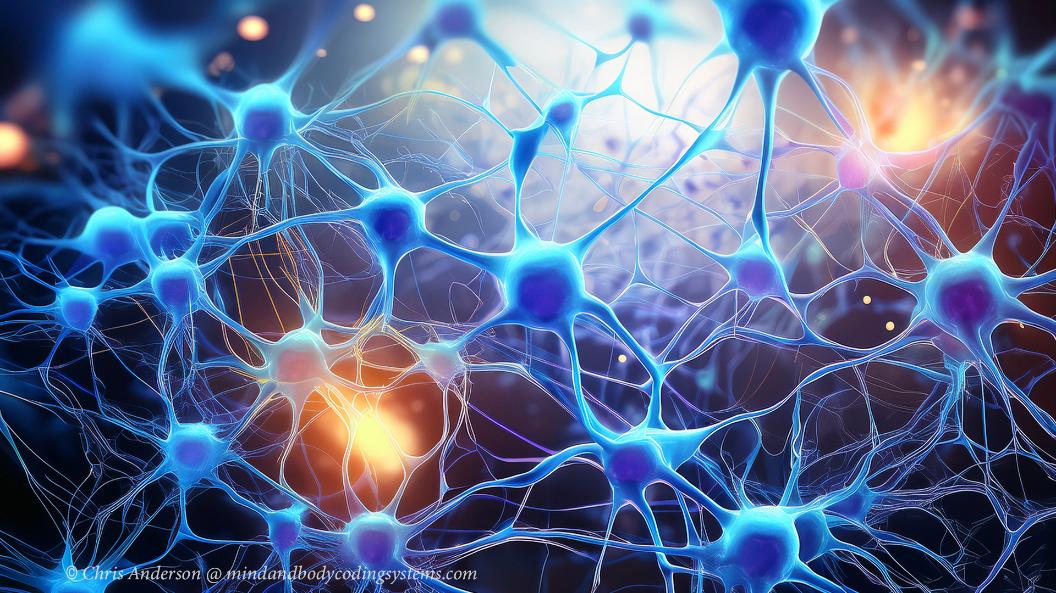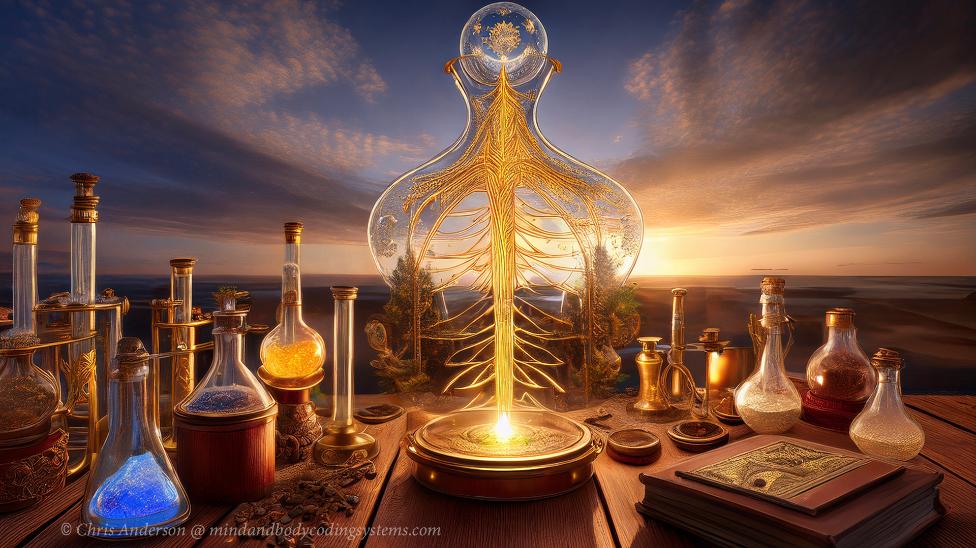
Master Your Brain Chemistry
© Copyrighted Material

Let's Talk About "Free Will"
You think you're in control. That every decision is yours. That you're the captain of your own ship.
Here's what's actually happening: Your brain chemistry is running the show. From what you eat to who you date to whether you hit the gym or hit the snooze button—it's all being influenced by invisible chemical messengers firing in your skull.
Today, I'm showing you exactly how three neurotransmitters influence your choices, and more importantly, how to work with them instead of against them.
Meet the Three Chemicals Running Your Life
Think of your brain as a chemistry lab that never closes. It's constantly mixing and releasing compounds that shape everything you think, feel, and do.
The big three? Dopamine, endorphins, and serotonin.
These three chemicals have more control over your life than your morning coffee, your boss, or your bank account combined.
Understanding them isn't just interesting—it's the key to finally making better decisions, creating new patterns, and achieving goals you've been putting off for years.
Let's break them down.

Dopamine: The Chemical That Makes You Want
What It Actually Does
People call dopamine the "feel-good hormone." That's not quite accurate. It's not about feeling good—it's about wanting.
Dopamine is your brain's reward chemical. It makes you crave, desire, and chase things.
Scrolling social media at 2 AM instead of sleeping? Dopamine.
Keep checking your phone? Dopamine.
Choosing junk food over a healthy meal? Dopamine.
Here's the kicker: dopamine doesn't wait for the actual reward. It gets released when you anticipate the reward. This is why planning a vacation is often more exciting than actually being on vacation. The anticipation was the real high.
The Dopamine Pattern

Dopamine reinforces behaviours. When you get rewarded for a choice, dopamine tells your brain: "Do that again." This creates a feedback loop.
This works beautifully when you're building helpful habits. It's less helpful when you're repeating patterns you'd like to change.
Low dopamine? That's when making decisions feels challenging. Everything seems less interesting. You might feel indifferent or unmotivated. I've been there—sitting in a taxi with friends, frozen by social anxiety, finding it difficult to enjoy myself. That was low dopamine at work.
How to Hack Your Dopamine
1. Move Your Body First
Physical activity boosts dopamine immediately. Even a 10-minute walk can shift your brain chemistry enough to make that hard decision easier. Do this BEFORE trying to decide anything important.
2. Remember Past Wins
Write down 3 times you've successfully handled a tough situation. Read them before making your decision. Your brain remembers: "We've done hard things before. We can do this." This triggers dopamine naturally.
3. Break It Down
Big decisions feel overwhelming. Break them into tiny steps. Instead of "Should I change careers?" ask "What's one small thing I can research today?" Small wins = dopamine hits = momentum.
4. Set a Decision Deadline
Give yourself a specific time limit. "I'll decide by 3 PM today." This creates urgency that triggers dopamine and prevents endless overthinking.
5. Build a Routine
Structure reduces decision fatigue. When you have a routine for small daily choices (what to eat, when to exercise), your brain saves dopamine for the big decisions that matter.
6. Use the 10-10-10 Rule
Ask: "How will I feel about this decision in 10 minutes? 10 months? 10 years?" This gives perspective without spiralling into worst-case scenarios.
7. Create a Victory Playlist
Make a playlist of songs that pump you up. Play it before making decisions. Music triggers dopamine and puts you in a confident state.
8. Manage Stress Daily
Chronic stress depletes neurotransmitters. Do ONE stress-reducing activity daily: 5-minute breathing exercise, 10-minute walk, or 15 minutes in nature. Non-negotiable.
9. Eat Right
Dopamine production requires specific nutrients:
• Bananas
• Avocados
• Nuts
• Dark chocolate
• Foods rich in tyrosine (the dopamine building block)

Endorphins: Your Natural High
The Real Deal
Endorphins are your body's natural painkillers and mood boosters. They're released during exercise, laughter, and social connection.
Ever heard of "runner's high"? That's endorphins flooding your system, creating euphoria and reducing pain.
But here's what most people miss: endorphins don't just make you feel good in the moment—they influence your future choices.
How Endorphins Shape Decisions
When you're in a good mood (thanks to endorphins), you make different choices. You're more optimistic, more willing to take positive risks, more likely to engage socially.
This creates a cycle:
Exercise → Endorphins → Good mood → Better choices → More exercise
The opposite is also true. Skip the gym, avoid people, and your endorphin levels drop. You feel worse, make worse choices, and the downward spiral continues.
Endorphin Hacks
1. Move Your Body
Any physical activity works—running, dancing, even vigorous cleaning. The key is intensity. You need to push yourself enough to trigger the release.
2. Laugh More
Genuine laughter releases endorphins. Watch comedy, spend time with funny friends, don't take life so seriously.
3. Connect Socially
Quality time with loved ones triggers the release of endorphins. This is why connection feels so good—you're literally giving your brain feel-good chemicals.
4. Try Something New
Novel experiences stimulate endorphin production. Break your routine, take a different route, try a new hobby.
Serotonin: The Calm Commander
Your Mental Stability Chemical
Serotonin regulates mood, focus, and your overall sense of calm. When serotonin levels are balanced, you experience mental clarity, motivation, and optimism. You can think clearly, analyse options rationally, and make decisions that align with your long-term goals.
Low serotonin? That's when anxiety, depression, and impulsive decision-making take over.
The Serotonin-Decision Connection
With adequate serotonin, you analyse choices carefully instead of acting impulsively. You can assess pros and cons, consider immediate effects and long-term consequences, and process setbacks constructively.
A positive mindset fueled by serotonin encourages resilience. Instead of being overwhelmed by obstacles, you focus on solutions. This proactive approach fosters personal growth and meaningful action toward your goals.
Boosting Serotonin Naturally
1. Get Sunlight
Sunlight exposure increases serotonin production. Aim for 15-30 minutes of natural light daily.
2. Eat Smart
Serotonin is made from tryptophan, found in:
• Turkey
• Eggs
• Cheese
• Nuts
• Seeds
• Salmon
3. Add Omega-3s
Fish oil or omega-3 supplements enhance serotonin levels. This is one supplement worth taking.
4. Practice Gratitude
Focusing on what you're grateful for triggers the release of serotonin. It's not woo-woo—it's biochemistry.
5. Meditate
Mindfulness practices increase serotonin and reduce stress hormones. Even 5 minutes daily makes a difference.
The Supporting Cast: Norepinephrine and Oxytocin
Norepinephrine: Your Focus Fuel
This neurotransmitter increases focus and energy, making it easier to evaluate options and make informed choices. It's your brain's "wake up and pay attention" signal.
Oxytocin: The Connection Chemical
Known for fostering social bonds, oxytocin impacts group decision-making by prompting you to prioritise choices that encourage connection and teamwork. It's why you make different decisions when you're with people you trust versus when you're alone.
The Formula for Peak Performance

Here's the secret: you don't need to optimise just one neurotransmitter. You need to create a favourable biochemical environment that enhances motivation and propels you toward your goals.
The formula is simple:
Physical Activity + Social Connection + Smart Nutrition + Mindfulness = Optimal Brain Chemistry
When you consciously implement these strategies, you create a biochemical cocktail that makes better decisions easier, motivation stronger, and life more fulfilling.
The NLP Exercise That Rewires Your Brain
Ready for something practical? This is the exercise I use when coaching clients to boost motivation by rewiring their brain's chemical responses.
"Visualising Your Future Self" Exercise
Objective: Boost motivation by envisioning your ideal future self and creating a neurological pathway to get there.
Step 1: Find Your Space
Locate a quiet, comfortable environment. Sit or lie down in a relaxed position.
Step 2: Centre Yourself
Take five deep breaths:
• Inhale deeply through your nose
• Hold briefly
• Exhale slowly through your mouth
This activates your parasympathetic nervous system and prepares your brain for visualisation.
Step 3: Define Your Intention
Focus on a specific goal where you desire increased motivation—career, health, relationships, or personal development.
Step 4: Visualise Your Future Self
Close your eyes and imagine yourself five years in the future:
• What do you look like?
• What are you wearing?
• Where are you?
• What are you doing?
Make it vivid. Engage all your senses—what do you see, hear, smell, feel?
Step 5: Connect with Your Future Self
In your visualisation, approach your future self. Notice:
• The qualities they embody
• The decisions they've made
• The obstacles they've overcome
Ask your future self:
• "What steps did I take to get here?"
• "What habits have I developed?"
• "What mindset changes helped me achieve my goals?"
Step 6: Receive Guidance
Listen to your future self's responses. Your subconscious mind is providing clarity and motivation. Don't judge or analyse—just receive.
Step 7: Step Into Your Future Self
Now, float out and down into your future self. Look out through their eyes onto that scene. Notice all those wonderful feelings. Try on this new, exciting future self like a suit of clothes.
This is where the magic happens—you're creating a neurological template for your brain to follow.
Step 8: Return to the Present
Gradually bring your awareness back. Count from one to five, feeling more alert with each count. When you reach five, open your eyes.
Step 9: Write It Down
Immediately capture the insights you gained. Write down
• Specific steps to take
• Habits to develop
• Mindsets to adopt
Step 10: Create Your Action Plan
Based on your insights, create an actionable plan for the next week. Identify small, manageable steps that will help you feel motivated and make progress.
Follow-Up
Revisit this exercise weekly. Visualise your future self again, adjusting your goals as you progress. Staying connected to your vision is a powerful motivator for change.
The Bottom Line
Your brain chemistry isn't your enemy—it's a tool. Once you understand how dopamine, endorphins, and serotonin influence your decisions, you can create strategies that work with your biology instead of against it.
The key is consistency. This exercise works best when practised regularly. You'll want to:
• Move your body regularly
• Connect with others meaningfully
• Feed your brain the right nutrients
• Practice mindfulness daily
• Use visualisation techniques consistently
Do this, and you'll create a supportive biochemical environment that aligns with your values and objectives. You'll maintain balanced neurotransmitter levels, improve your decision-making capabilities, and lead a more satisfying life.
This isn't magic—it's science. And now you know the formula.
To your greatness and success,
Chris Anderson (Chris Uncensored)
© ABNLP Certified NLP Practitioner | NLP Coach Practitioner | Hypnosis Practitioner | Timeline Therapy™ Practitioner
Take Action Now
Ready to master your brain chemistry and transform your decision-making? Here's what to do next:
1. Try the visualisation exercise today - Spend 15 minutes connecting with your future self
2. Track your neurochemicals - Notice how different activities affect your mood and motivation
3. Implement one habit - Choose one strategy from this post and commit to it for 7 days
4. Share your biggest insight - Join my Facebook Group and tell us what resonated with you most
5. Create your compelling future - Get my book "Create Your Compelling Future: A Blueprint for Personal Transformation" to turn your vision into reality
6. Build unshakeable confidence - Check out "The Confidence Toolkit: Essential Strategies for Building Self-Worth and Self-Empowerment"
Remember: You're not a victim of your brain chemistry. You're in control. Use it wisely.
Ready to Go Deeper?
Create Your Compelling Future
The perfect companion to this article! Learn how to use the visualization techniques you just discovered to design and achieve your ideal life.
Get the BookThe Confidence Toolkit
Master the dopamine-driven confidence strategies that transform how you show up in the world.
Get the BookJoin the Conversation
Join my private Facebook community, The Mindset Toolkit Collective, where we discuss personal development, NLP techniques, and life-changing strategies!
Join The Mindset Toolkit Collective Group! →